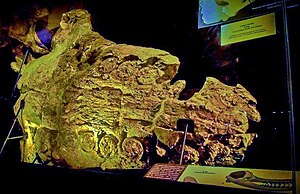Livyatan
| Livyatan | ||||||||||||
|---|---|---|---|---|---|---|---|---|---|---|---|---|

Skull of Livyatan Melvillei in the Natural History Museum of Lima (view from below). |
||||||||||||
| Temporal occurrence | ||||||||||||
| Middle Miocene ( Serravallian ) | ||||||||||||
| 13 to 12 million years | ||||||||||||
| Locations | ||||||||||||
|
||||||||||||
| Systematics | ||||||||||||
|
||||||||||||
| Scientific name | ||||||||||||
| Livyatan | ||||||||||||
| Lambert , Bianucci , Post , de Muizon , Salas-Gismondi , Urbina & Reumer , 2010 | ||||||||||||
| Art | ||||||||||||
|
||||||||||||
Livyatan is an extinct genus of sperm whales from the Middle Miocene 13 to 12 million years ago. The only known species, Livyatan melvillei , was described in 2010 on the basis of a 75% preserved skull and an anterior part of the lower jaw covered with teeth. The fossils were found in 2008 in the Pisco Formation in southern Peru (35 km southwest of Ica ).
The genus was named after the biblical-mythological sea monster Leviathan and the species Livyatan melvillei after the author of the novel Moby Dick , Herman Melville . Since the generic name Leviathan had already been introduced in 1841 (today considered a synonym for the genus Mammut Blumenbach, 1799), the generic name was changed a little later by the descriptors to the Hebrew form Livyatan .
features
The skull has a length of three meters and is 1.9 meters wide at the widest point, the teeth in the upper and lower jaw reach a diameter of 8.1 to 12.1 centimeters and a maximum length of 36 centimeters. The teeth, along with the jawbones, are one of the largest vertebrate biting tools and the largest known tetrapod ever found. In each branch of the lower jaw (dental) there are eleven deep tooth sockets (alveoli), in each maxillary nine. The premaxillary is toothless. With the exception of a few individuals of the dwarf sperm whale, Livyatan had the fewest teeth of all sperm whale relatives.
The muzzle is short and only slightly longer than the rear skull. It is broad at the base and tapering to a point. A large concave structure on Livyatan's front skull may have contained an organ filled with whale rat . The skull window is very large and differs significantly from the smaller skull window of the sperm whale. The total length of the whale is estimated to be 13.5 to 17.5 meters. He was thus the largest sperm whale relative found so far.
ecology
Because of the strong dentition, the researchers suspect that Livyatan melvillei , similar to the great shark Otodus megalodon, who lived at the same time, fed on larger vertebrates; large fish, seals and baleen whales, among others . The Miocene was a high point for the diversity of the baleen whales, so far more than 25 genera have been identified, and at the site of Livyatan more than 20 skeletons of a hitherto unknown baleen whale from the Cetotheriidae family have been found. Livyatan thus occupied a completely different ecological niche than the sperm whale, which feeds on deep-sea cephalopods . With the end of the mid-Miocene climatic optimum, the biodiversity of the baleen whales declined and the predatory sperm whale relatives of large vertebrates died out. Their ecological role was later taken over by the killer whales from the dolphin family .
Systematics
Livyatan melvillei is related to the recent sperm whale and dwarf sperm whale , but differs from them mainly in its toothed upper jaw. The systematic position of Livyatan melvillei illustrates the following cladogram :
| Physeteroidea |
|
||||||||||||||||||||||||||||||||||||||||||||||||||||||||||||||||||||||||||||||||||||
|
|
literature
- Olivier Lambert, Giovanni Bianucci, Klaas Post, Christian de Muizon, Rodolfo Salas-Gismondi, Mario Urbina & Jelle Reumer: The giant bite of a new raptorial sperm whale from the Miocene epoch of Peru. In: Nature . Volume 466: pp. 105-108, July 1, 2010, doi: 10.1038 / nature09067 .
Individual evidence
- ↑ Olivier Lambert, Giovanni Bianucci, Klaas Post, Christian de Muizon, Rodolfo Salas-Gismondi, Mario Urbina, Jelle Reumer: The giant bite of a new raptorial sperm whale from the Miocene epoch of Peru (Corrigendum) . In: Nature . tape 466 , 2010, p. 1134 (English, full text ).
Web links
- The Paleobiology Database Livyatan
